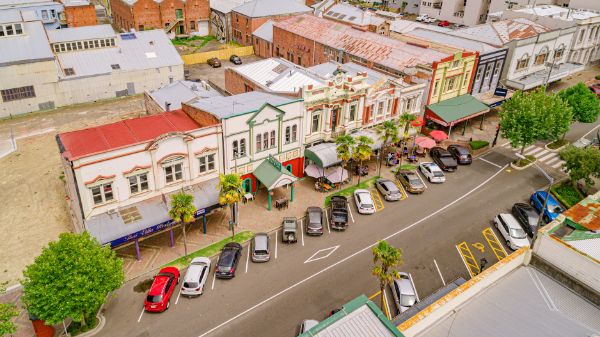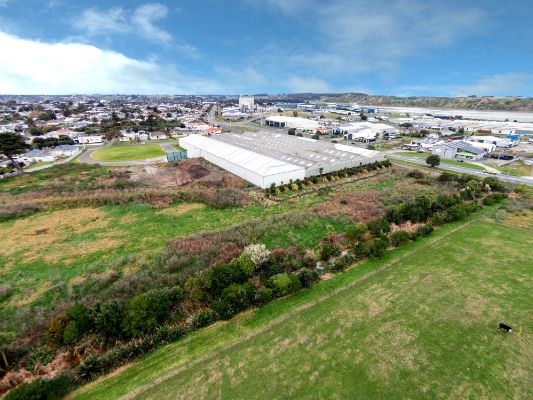More Industrial Land In The Wings To Satisfy Whanganui Demand
Growing demand for industrial property in Whanganui is likely to see a new development released to the market in the coming months.
Bayleys commercial and industrial sales and leasing salesperson Jordan Davis expects details to emerge shortly about a circa 10ha site.
Mr Davis said there was a shortage in supply of land available to the market, either developed, subdivided, title issued with services, or for sale with the potential to be developed.
Bayleys is currently offering the last block in the Mill Road development and Rakau Road subdivision where all but one section is under offer and buildings could be constructed within the next 24 months, said Mr Davis who is Bayleys Whanganui’s new commercial and industrial sales and leasing salesperson.
“Recently released local body property valuations suggest an increase in industrial zoned land of double their previous value, compared with the last valuations struck three years ago,” said Mr Davis.

“The Mill Road industrial park on the rural outskirts was rezoned by the Whanganui District Council in the late 1990s to ensure a sufficient pipeline of industrial land.
It has been developed for industrial use by local firm, A T Wanganui, owned by Whanganui and Rangitikei businessmen.”
It took some time for the development to gain traction but Russell Duggan at Bayleys Whanganui, said it has become a viable option to the shortage of available industrial zoned land.
Mr Davis said that businesses which have set up at Mill Road include Castlecliff Health, Parkwood, C P Wool and the most recent addition of Wight Aluminum’s new build down the road.
“Some local businesses are outgrowing their current premises, and others were considering long-term plans to purchase their own site,” Mr Davis said.
“There had also been increased interest from outside of Whanganui because prices remain reasonable compared with other towns and cities.”
Whanganui’s historical industrial precinct closer to town is Heads Road West, the largest manufacturing zoned area of approximately 114ha.
In 2017, there were 170 businesses employing 3090 people, representing about 89 percent of the employment in the area. The industries located on Heads Road West include meat processing, road freight transport, leather tanning, fur dressing and leather product manufacturing, and animal and bird feed manufacturing.
A report for the district council by M.E. Consulting in January 2019 said there were a number of planning constraints affecting future development at Heads Road West such as stormwater and wastewater pumping station capacity.
Mr Davis said his analysis of the market showed square metre rates for developed land in the Heads Road area, Mill Road area and inner-city commercial area had grown substantially since the last local body valuations and could entice owners to sell down and receive capital gain.
“Industrial warehousing for lease and for sale is also in high demand by owner-occupiers and investors, particularly as yields remain generous compared with other investment returns such as bank deposits, and were relatively lower in risk,” Mr Davis said.

Expected return rates on investment property sit around 7.25 to 8 percent, and Bayleys expects more investor interest nationally as the insatiable search for yields continue.
“The Heads Road industrial precinct remains the location of choice for industrial use warehousing and is likely to remain so in the years to come with the port incentives and dry dock location, although, we anticipate steady migration out to the industrial park on Mill Road as more sites and businesses look to set up shop out there,” Mr Davis said.
He expected the investor demand to increase in interest locally and nationally.
The demand would be satisfied by existing industrial zoned landowners developing their assets or freeing them up for development, as long as realistic sale prices were considered to allow development.
“Owners of industrial properties will continue to weigh up selling as they compare against other investments that offer little to no return in comparison to the generous property yields they have become accustomed to,” Mr Davis said.
At the same time, some owners will be tempted to sell down given the recent increases in land value, increased regional investment, and high local demand, he said.
Aramoho to the north of the CBD on the western side of the Whanganui River is the third largest manufacturing zoned area in Whanganui, at about half the size of Heads Road West and Mills Rd.
Coming fourth in size is Heads Road East, with a handful of smaller precincts such as Eastown to the north of the CBD on the eastern side of the Whanganui River.
Employment in Whanganui is expected to increase in the medium term (to 2028) by 980 jobs (5 percent) with more than half created in the industrial sectors.
The majority of the growth is expected to occur in the construction industry.
Over the past two years there has been stronger population growth, reflecting anecdotal evidence of people choosing to move from larger cities due to the cost of housing. The district council is expecting an average increase of 200 people a year which would see the district grow to 47,200 people by 2028.


 Gordon Campbell: On The Hikoi Aftermath
Gordon Campbell: On The Hikoi Aftermath Infrastructure New Zealand: Single Agency Needed To Coordinate Climate Adaptation And Recovery
Infrastructure New Zealand: Single Agency Needed To Coordinate Climate Adaptation And Recovery Free Speech Union: Fair Digital News Bargaining Bill Likely To Restrict Access To Information, Polling Shows Most Oppose
Free Speech Union: Fair Digital News Bargaining Bill Likely To Restrict Access To Information, Polling Shows Most Oppose Auckland Transport: Driver Safety Screens Now Rolling Out Across Auckland’s Bus Fleet
Auckland Transport: Driver Safety Screens Now Rolling Out Across Auckland’s Bus Fleet People Against Prisons Aotearoa: 'Expect Resistance' - Community Group Pushes Back Against More Cops With Guns
People Against Prisons Aotearoa: 'Expect Resistance' - Community Group Pushes Back Against More Cops With Guns Greenpeace: New Zealand Drops In Global Ranking On Climate Action
Greenpeace: New Zealand Drops In Global Ranking On Climate Action PSA: Spending Cuts Need To Stop - PSA Urges Govt To Listen To Economists
PSA: Spending Cuts Need To Stop - PSA Urges Govt To Listen To Economists


